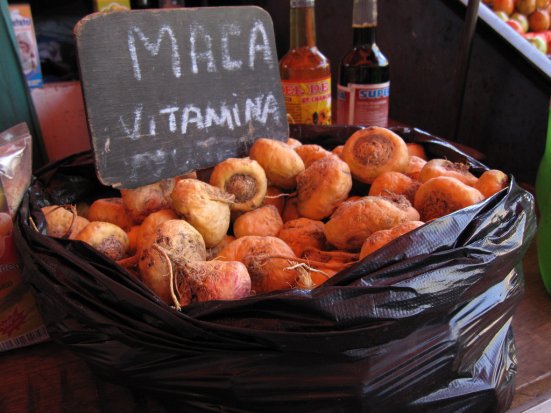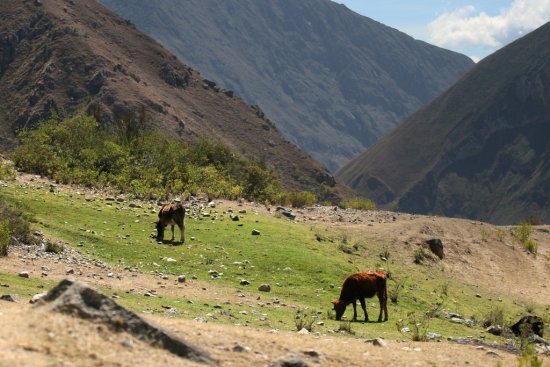Previous findings show that the highland soil is very carbon-rich, while at the same time scarcely documented (PDF), urging for a better overview of its underground wealth. Given the importance that soil plays as carbon sinks and for the climate, an interdisciplinary research project led by the International Potato Centre (CIP) has carefully assessed the carbon stocks of the central Highlands in Peru.
As the highland carbon plays an important role in the ecosystem, any disturbance to the landscape’s rolling grasslands will have huge implications, for the growth of greenhouse gas emissions due to the subsequent release of carbon.
Because of a number of recent land-use changes in the region the research team decided to not only estimate carbon levels, but also investigate which factors drive soil disturbances, along with the effects of converting natural rangelands into croplands for both men and women.
“The carbon-estimates we are working on will help inform mitigation policies for the Andean region,” says Roberto Quiroz, project activity leader and researcher at the International Potato Center (CIP).
“But as important as the carbon estimates are, we also need to improve our understanding of social and economic aspects that influence land-use change and disturbances to the landscape. A better understanding of the drivers will help strengthen Peru’s climate mitigation activities,” adds Cecilia Turin, gender researcher within the team.
While investigating drivers and underlying processes of landscape changes, the team became very aware that they had to look particularly at the rushing maca production.
The maca boom in the Peruvian highlands
Maca is a medicinal plant cultivated in the Peruvian Andes, highly appreciated for its energetic benefits and mostly sold on the Asian markets. As buyers from Asia are paying very high prices for the plant, the production has expanded rapidly in the area.
Historically, maca was only produced for consumption on small plots, but now cultivation has expanded to privately owned land and communal land, previously reserved for grazing livestock.

Photo: Maca products sold at a local market. Credit: Jagubal
The maca encroachment has environmental, social and economic effects. One significant environmental effect is the release of carbon to the atmosphere and the decrease in carbon stocks in cropped areas.
Because maca is such a troublesome plant, depleting all soil nutrients, it is leaving the central Andean highlands infertile and in some cases unproductive for almost a decade.
Using a gender-lens to analyse land-use change
While looking at the social and economic effects, the team explored development opportunities for women and men brought about by the maca cultivation and reduction in livestock grazing, a main income-source for women.
An adapted version of the Women’s Agricultural Empowerment Index (WAEI) survey was used to interview 323 farmers, including 189 women, in six rural communities with different land tenure regimes.
“At a first glance, the maca cultivation might seem like a profitable activity,” says Maria Montenegro, Master student of the University of Alberta part of the research project, “and there are smallholders benefitting from the expansion. However, limited access to land and investment capital limits participation for most farmers, both men and women”
“However we did find that the maca production boom in particular do not favor women,” adds Cecilia Turin, gender researcher at the International Potato Center (CIP).
In fact, many farmers, and especially women-headed households, face severe barriers to participation in livelihoods other than grazing livestock. Thus, although there are new job opportunities due to maca expansion for post-harvest processing, women do not usually participate.

Photo: Women’s main income and livelihood, livestock grazing, is threatened by the recent maca-production boom in the Peruvian highlands.
Women and men didn’t directly link changes in livelihoods to maca, according to the survey. However, women shared that they had lost decision-making power around land management, and few stated any benefits from the maca-boom.
The maca-boom appears to have negative socio-economic and gender-based consequences, and high environmental costs in terms of lost soil productivity.
View the study presentation held at the Gender event on 19 March in Paris:
Generating gender-responsive policies
Peru is also experiencing competing goals,as the national mitigation targets do not align with economic development goals to expand maca production.
At the moment, the governmental program “Sierra Exportadora” is encouraging maca-conversions as a way to increase diversification options and further enabling development and economic growth. However, the economic gains are in reality limited, and maca-production is causing significant soil carbon losses. In addition, neither the national mitigation work nor the development program has incorporated gender in any of the policies.
“The policies should be re-formulated to better address gender inequities created by the maca production. This would ensure that gender-based negative impacts are prevented by the program,” says Cecilia Turin.
Given their leading roles in livestock management women could help conserve soil carbon in the Andean Highlands. Climate change mitigation policies should thus consider gender impact.
Whether maca continues to expand or not, mitigation actions for the Andes must find incentives to avoid further loss of grazing land and soil carbon, as well as incorporate fertility restoration in areas used for maca.
To ensure gender and better land management practices are better taken into consideration, the International Potato Center and CGIAR Research Program on Climate Change, Agriculture and Food Security (CCAFS) are working directly with policy-makers within the Peruvian High Directorate of Agricultural Policies of the Ministry of Agriculture and Irrigation (MINAGRI).
In essence, it will require the cooperation of all and strong gender, social justice, and climate-sensitive lenses to formulate equitable and appropriate actions for mitigation work in the Andean agriculture national action mitigation (NAMA) plan.
The research project is part of the CGIAR Research Program on Climate Change, Agriculture and Food Security (CCAFS) flagships “Low-Emissions Agriculture” and “Policies and Institutions for Climate-Resilient Food Systems”.
Originally published on ccafs.cgiar.org
